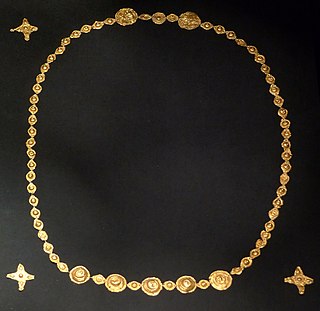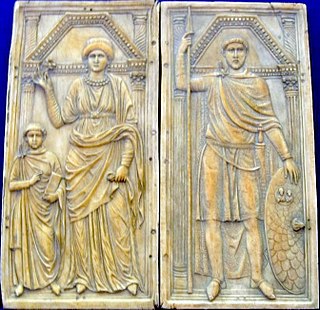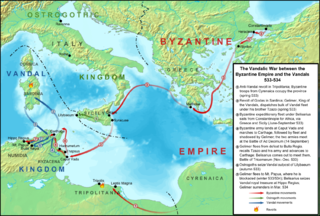
Theodoricthe Great, also called Theodoric the Amal, was king of the Ostrogoths (471–526), and ruler of the independent Ostrogothic Kingdom of Italy between 493 and 526, regent of the Visigoths (511–526), and a patrician of the Eastern Roman Empire. As ruler of the combined Gothic realms, Theodoric controlled an empire stretching from the Atlantic Ocean to the Adriatic Sea. Though Theodoric himself only used the title 'king' (rex), some scholars characterize him as a Western Roman Emperor in all but name, since he ruled large parts of the former Western Roman Empire, had received the former Western imperial regalia from Constantinople in 497, and was referred to by the title augustus by some of his subjects.

The Vandals were a Germanic people who first inhabited what is now southern Poland. They established Vandal kingdoms on the Iberian Peninsula, Mediterranean islands, and North Africa in the fifth century.

Flavius Stilicho was a military commander in the Roman army who, for a time, became the most powerful man in the Western Roman Empire. He was of Vandal origins and married to Serena, the niece of emperor Theodosius I. He became guardian for the underage Honorius. After nine years of struggle against barbarian and Roman enemies, political and military disasters finally allowed his enemies in the court of Honorius to remove him from power. His fall culminated in his arrest and execution in 408.

The Western Roman Empire comprised the western provinces of the Roman Empire at any time during which they were administered by a separate independent Imperial court; in particular, this term is used in historiography to describe the period from 395 to 476, where there were separate coequal courts dividing the governance of the empire in the Western and the Eastern provinces, with a distinct imperial succession in the separate courts. The terms Western Roman Empire and Eastern Roman Empire were coined in modern times to describe political entities that were de facto independent; contemporary Romans did not consider the Empire to have been split into two empires but viewed it as a single polity governed by two imperial courts as an administrative expediency. The Western Roman Empire collapsed in 476, and the Western imperial court in Ravenna was formally dissolved by Justinian in 554. The Eastern imperial court survived until 1453.

The Theodosian dynasty was a Roman imperial family that produced five Roman emperors during Late Antiquity, reigning over the Roman Empire from 379 to 457. The dynasty's patriarch was Theodosius the Elder, whose son Theodosius the Great was made Roman emperor in 379. Theodosius's two sons both became emperors, while his daughter married Constantius III, producing a daughter that became an empress and a son also became emperor. The dynasty of Theodosius married into, and reigned concurrently with, the ruling Valentinianic dynasty, and was succeeded by the Leonid dynasty with the accession of Leo the Great.

Mauretania Sitifensis was a Roman province in Northwest Africa. The capital was Setifis.

The Vandalic War was a conflict fought in North Africa between the forces of the Byzantine Empire and the Vandalic Kingdom of Carthage in 533–534. It was the first of Justinian I's wars of reconquest of the Western Roman Empire.
The praetorian prefecture of Africa was an administrative division of the Eastern Roman Empire in the Maghreb. With its seat at Carthage, it was established after the reconquest of northwestern Africa from the Vandals in 533–534 by the Byzantine Emperor Justinian I. It continued to exist until 591, when it was replaced by the Exarchate of Africa.
Artabanes was an East Roman (Byzantine) general of Armenian origin who served under Justinian I. Initially a rebel against Byzantine authority, he fled to the Sassanid Persians but soon returned to Byzantine allegiance. He served in Africa, where he won great fame by killing the rebel general Guntharic and restoring the province to imperial allegiance. He became engaged to Justinian's niece Praejecta, but did not marry her due to the opposition of the Empress Theodora. Recalled to Constantinople, he became involved in a failed conspiracy against Justinian in 548/549, but wasn't punished severely after its revelation. He was soon pardoned and sent to Italy to fight in the Gothic War, where he participated in the decisive Byzantine victory at Casilinum.
John Troglita was a 6th-century Byzantine general. He participated in the Vandalic War and served in North Africa as a regional military governor during the years 533–538, before being sent east to the wars with the Sassanid Persians. As dux Mesopotamiae, Troglita distinguished himself in several battles, and was noticed by agents of the Byzantine emperor, Justinian I. In summer 546, Justinian chose John Troglita to assume overall command of Byzantine forces in Africa, where a succession of revolts by the indigenous Moorish tribes and within the imperial army itself had seriously reduced the Byzantine position. Troglita quickly secured an initial victory in the winter of 546/547 against the Moors of Byzacena, but was defeated in summer 547 by the tribes of Tripolitania, and Africa was once again laid open to destructive raids. Troglita reorganized his army and secured the assistance of some tribal leaders, and confronted and decisively defeated the tribal coalition at the Fields of Cato in summer 548. This victory spelled the end of the Moorish revolt and heralded an era of peace for Africa. Troglita was also involved in the Gothic War, twice sending some of his troops to Italy to assist against the Ostrogoths.

Mauri was the Latin designation for the Berber population of Mauretania, located in the part of North Africa west of Numidia, in present-day northern Morocco and northwestern Algeria.
Stotzas, also Stutias, Theophanes writes him Tzotzas (Τζότζας), was an East Roman (Byzantine) soldier and leader of a military rebellion in the Praetorian prefecture of Africa in the 530s. Stotzas attempted to establish Africa as a separate state and had been chosen by the rebelling soldiers as their leader. Nearly succeeding in taking Carthage, Stotzas was defeated at the Battle of the River Bagradas by Belisarius and fled into Numidia, where he regrouped. After another attempt at taking control of Africa, Stotzas was defeated by Germanus in 537 and fled with some of his followers into Mauretania.
Praejecta or Praiecta was a niece to Byzantine emperor Justinian I by blood and of his empress Theodora by marriage.

Mastigas or Mastinas ruled the Mauro-Roman Kingdom during the sixth century as King of the Moors and Romans, succeeding Masuna. During the reign of Mastigas, the Mauro-Roman Kingdom governed almost the entire ancient Roman province of Mauretania Caesariensis, except for the former capital of Caesarea which was held by the Eastern Roman Empire.

The Vandal Kingdom or Kingdom of the Vandals and Alans was established by the Germanic Vandal people under Gaiseric. It ruled in North Africa and the Mediterranean from 435 to 534 AD.
Antalas was a Berber tribal leader who played a major role in the wars of the Byzantine Empire against the Berber tribes in Africa. Antalas and his tribe, the Frexes initially served the Byzantines as allies, but after 544 switched sides. With the final Byzantine victory in his and his tribe once again became Byzantine subjects. The main sources on his life are the epic poem Iohannis of Flavius Cresconius Corippus and the Histories of the Wars of Procopius of Caesarea.
John, referred to as John the Tyrant and sometimes given the nickname Stotzas the Younger after his predecessor, Stotzas, was a Berber military leader and briefly King of the Mauro-Roman Kingdom following the death of his predecessor. Given his name, Ioannes, John was probably, like Stotzas, of Eastern Roman descent and only briefly commanded his army against the Eastern Roman Empire.
The Battle of Thacia took place in the autumn of 545, in Thacia. The Byzantine loyalists led by John the Armenian confronted the Berber rebel Antalas and his ally Stotzas, a renegade Byzantine. In the clash, the outnumbered Byzantines were defeated and John was killed, but not before mortally wounding Stotzas. The Byzantine rout triggers a crisis in Carthage.
The Moorish wars were a series of wars fought between the Byzantine Empire attempting to restore all of Roman North Africa, and the various Berber kingdoms and Nomads which formed after the collapse of Roman rule over the region. The war also featured other rebels such as the renegades of Stotzas and the Vandalic rebels of Guntarith. The war ended with the Berbers attempting to push the Romans out of Africa being defeated at the battle of the Fields of Cato, and the Byzantines being too weakened to take over the various newly formed kingdoms such as Altava and the Kingdom of the Aurès.
Sergius was a Byzantine military officer who was active in Byzantine Africa during the reign of the emperor Justinian I. The son of a priest named Bacchus, he was the brother of two Byzantine officers and nephew of the famous general Solomon. When appointed governor of Tripolitania, he murdered 80 of the leaders of the Laguatan, which intensified hostilities with the Moorish tribes.









